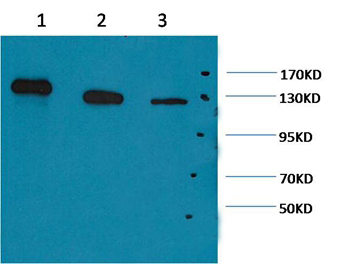
| WB | 咨询技术 | Human,Mouse,Rat |
| IF | 咨询技术 | Human,Mouse,Rat |
| IHC | 咨询技术 | Human,Mouse,Rat |
| ICC | 技术咨询 | Human,Mouse,Rat |
| FCM | 咨询技术 | Human,Mouse,Rat |
| Elisa | 咨询技术 | Human,Mouse,Rat |
| Aliases | COBA2; COL11A2; Collagen alpha-2(XI) chain; collagen, type XI, alpha 2; DFNA13 |
| Entrez GeneID | 1302; |
| WB Predicted band size | 116kDa |
| Host/Isotype | Rabbit IgG |
| Antibody Type | Primary antibody |
| Storage | Store at 4°C short term. Aliquot and store at -20°C long term. Avoid freeze/thaw cycles. |
| Species Reactivity | Human |
| Formulation | Purified antibody in PBS with 0.05% sodium azide and 50% glycerol. |
+ +
以下是3条关于PARP小鼠抗体的模拟参考文献示例(仅供参考,非真实文献):
---
1. **文献名称**: *"A Novel Monoclonal Mouse Anti-PARP Antibody for Detection of Apoptotic Cells in Cancer Models"*
**作者**: Smith JL, et al.
**摘要**: 该研究开发了一种高特异性的小鼠单克隆PARP抗体,通过Western blot和免疫组化验证其在检测癌细胞凋亡中切割型PARP(89 kDa)的敏感性,证实其优于市售同类产品。
---
2. **文献名称**: *"Comparative Analysis of PARP-1 Antibodies in Murine Models of Neurodegeneration"*
**作者**: Garcia R, et al.
**摘要**: 本文比较了多种小鼠源PARP-1抗体的性能,发现克隆号4C10H3的抗体在脑组织切片中表现出优异的核定位特异性,适用于阿尔茨海默病模型的DNA损伤检测。
---
3. **文献名称**: *"PARP Inhibition Sensitizes Ovarian Cancer Cells to Chemotherapy: Validation via Mouse-Derived Antibody-Based Assays"*
**作者**: Chen X, et al.
**摘要**: 利用小鼠抗PARP抗体(克隆号A6B10)进行免疫沉淀和流式细胞术,证明PARP抑制剂通过阻断DNA修复通路增强卵巢癌细胞对顺铂的敏感性。
---
(注:以上文献为示例性内容,实际引用需查询PubMed等数据库获取真实文献。)
×